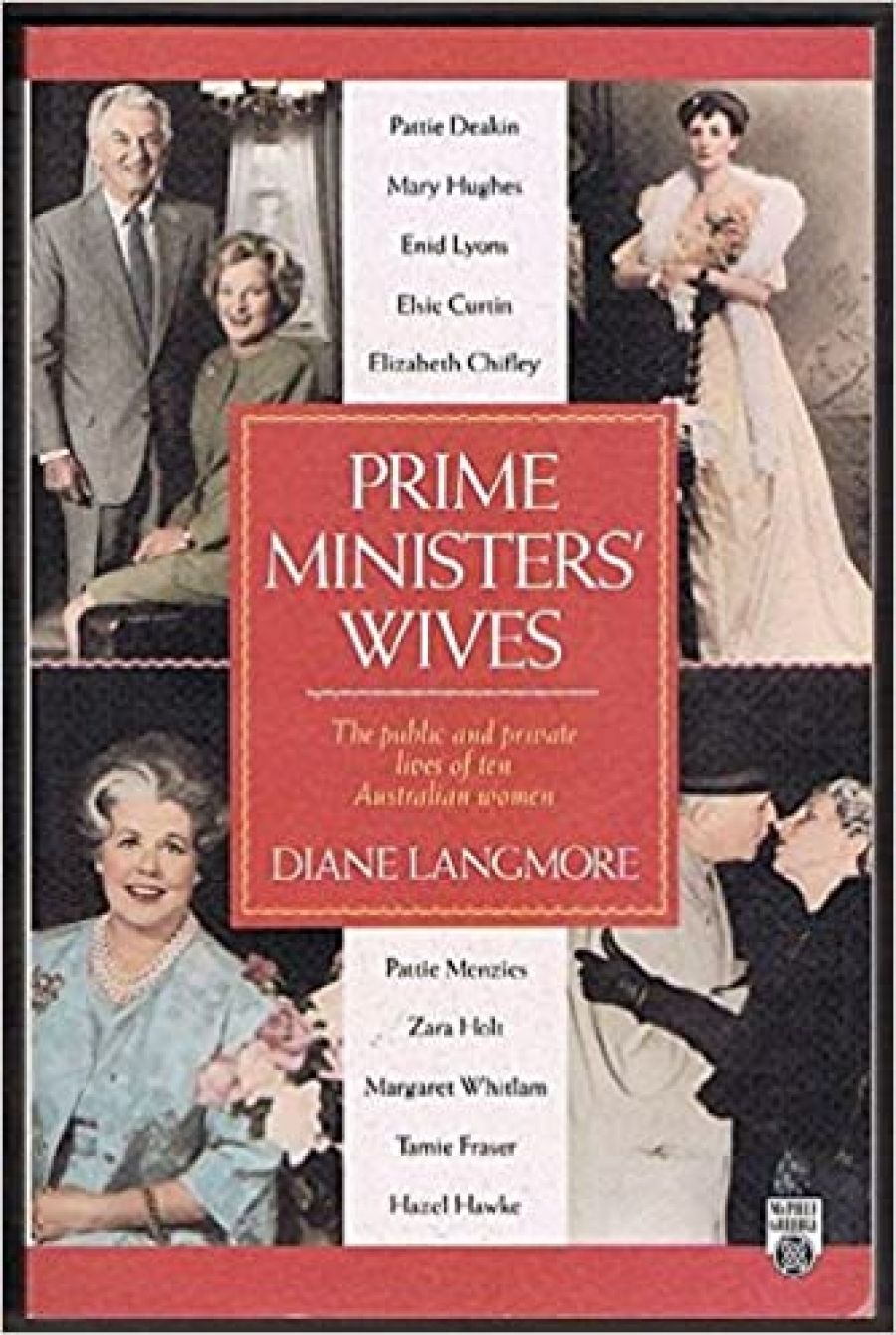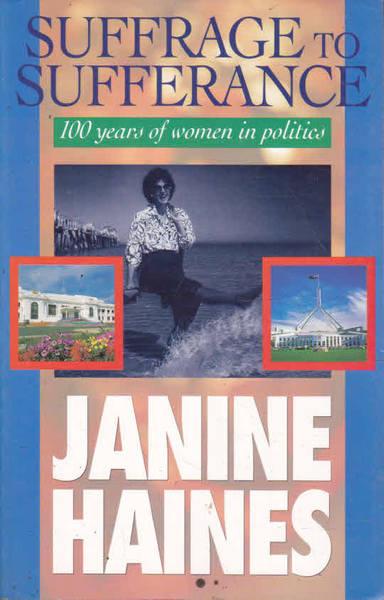
- Free Article: No
- Contents Category: Australian History
- Review Article: Yes
- Online Only: No
- Custom Highlight Text:
Diane Langmore has given us a fascinating account of the lives of ten women, from Pattie Deakin to Hazel Hawke. She has explored the background of each, the attraction which ended in marriage to a politically ambitious man, and the adaptation of each to her husband’s obsessive struggle for the most powerful political post in Australia. Her analysis of the women’s relationship to their partners throws light on the personalities and attitudes of the men chosen by Australians to lead the nation. For the early sketches Langmore has drawn on diaries, newspaper reports, and the opinions of contemporaries; for the latter she has been able to add to her sources the opinions and musings, given in interviews, of the women themselves. Langmore writes with clarity and style, never belittling or patronising her subjects, and her sympathetic viewpoint enables the reader to appreciate the varied personalities of her subjects. She does not, however, fall into the trap of assuming that the public face of each woman is always the private one.
- Book 1 Title: Prime Ministers’ Wives
- Book 1 Subtitle: The public and private lives of ten Australian women
- Book 1 Biblio: McPhee Gribble, $24.95 pb, 341 pp
- Book 2 Title: Suffrage to Sufferance
- Book 2 Subtitle: 100 years of women in politics
- Book 2 Cover (800 x 1200):

The book is much more than a readable account of the experiences of ten women – or eleven, if one includes the short sketch of Elizabeth, the de facto wife of ‘Billy’ Hughes, who bore him six children and died before he became prime minister. Each woman’s interpretation of her responsibilities during her husband’s term of office exposes the contradictions and ambiguities inherent in a public post with no guidelines and no clear definition. When Australians ‘elect’ a male prime minister we expect, as some of the women themselves point out, to have ‘two for the price of one’. If the woman has strong political opinions of her own she is expected to hide them. If she expresses strong opinions on any of the burning questions of her time she can find herself under attack – as Margaret Whitlam discovered when she showed her developing feminism by becoming involved in International Women’s Year. She must be a public person by making herself available to the State to host its most important functions, but she must not expect remuneration for her services.
Most of the women in this study have seen their primary role in traditional terms. They have relieved their husbands of all domestic responsibilities by caring for any children; they have handled the transfer to the lodge, the appointment of staff and the adaptation of the residence to their families’ and their husbands’ requirements; and by their comfort and encouragement they have provided a centre of rest and refreshment for partners fatigued by the cares of office. There are exceptions: Elsie Curtin, as she and John Curtin wished, maintained a home for the children in Perth, although she spent long periods at the Lodge; and the fiercely private, childless and frail Elizabeth Chifley made only rare visits to Canberra, leaving Chifley’s private secretary to fulfil the ‘caring’ role.
For all that they have seen their first responsibility as supportive, the women have shown great initiative in opening up avenues of interest and expertise which would not have been available to them otherwise. In many cases they have carried these interests into their Post-Lodge lives, and in so doing have enlarged their own spheres. Of differing backgrounds, they have enjoyed the stimulation of mixing with and entertaining a wide range of people and have, on the whole, handled such contacts with grace and ease.
The book raises questions. The position of the prime minister’s wife is an ambiguous one, but to define it would be to place restrictions on the woman who finds herself in the Lodge simply because she has married a particular man. What will happen when, as is likely in the future, the wife of the prime minister has a demanding career of her own and is not prepared to subordinate it for the period of her husband’s occupancy? Zara Holt had to deal with that problem and its ensuing tensions. Will the husband of a female prime minister be prepared to put his career on hold to act as host in the official residences and patron of good causes? And will he consider a secretary and an expense account to be sufficient reward for these services?
This is an interesting and thought-provoking book.
Janine Haines may have retired (or been retired) from Federal Parliament, but she certainly hasn’t left politics. Her book is an incisive and at times caustic account of the difficulties women have had in making their voices heard and their interests taken into consideration in Australian legislatures. Her research is augmented by experiences from the time of her 1977 appointment to fill a casual vacancy in the Senate (where she survived three elections and became the leader of the Democrats) to her narrow defeat in 1990 when attempting to transfer from the Senate to the House of Representatives. She, of all people, is qualified to assess the attitude of many male MPs, sometimes hostile but more often patronising and flippant, towards women in Parliament – attitudes that in some cases have changed little from the time Vida Goldstein stood unsuccessfully for Commonwealth Senate in 1903.
The book is introduced by a summary of late nineteenth- and early twentieth-century woman suffrage campaigns in Britain, America, New Zealand and Australia, and arguments for and against votes for women. Its main concern, however, is to trace the representation of women in Australian Parliaments, to analyse why there have been so few, and to compare the Australian record with that of other major democracies. I enthusiastically endorse her thesis that the party political machines must bear the brunt of the blame. Until recently they either refused to nominate women or, when they did so, rarely gave them permission to stand for winnable seats.
From the time all political parties campaigned against Goldstein on the grounds that a vote for an independent woman candidate was a vote lost to one of them, major parties have contended that women could not win elections. They have then made it impossible for them to do so, so fallaciously ‘proving’ their own argument. Women were given the right to stand as Commonwealth candidates in 1902, but only in 1945 did the first two make it to those parliamentary benches. The first woman elected to any Australian parliament, Edith Cowan in Western Australia, was allowed to stand in 1921 as a second endorsed candidate for a seat held by another National, the attorney-general. With an election committee from women’s organisations, Cowan wrested the seat from him. The National Party did not make the same mistake twice; at the next election it campaigned against her as an unendorsed candidate and she was defeated.
Haines’s account of the experience of Jessie Cooper, the first woman to gain a seat in the South Australian parliament (for which women were given the right to stand in 1894) is particularly revealing. The first to be endorsed for a winnable position, she found herself in 1959 in the Supreme Court defending a challenge that she was not a ‘person’ in the political meaning of the term.
This book’s third concern is to point to the slow pace this century of legislation that guarantees women’s legal, political, social, and economic equality. Women must be elected to Commonwealth and State Parliaments in sufficient numbers to force consideration of all legislation, by whatever political group, in terms of its impact on women; they must be an integral part of the drafting process, not left on the margins to influence male legislation. Numbers of women in all Australian Parliaments have increased in the 1980s, but they now

Comments powered by CComment